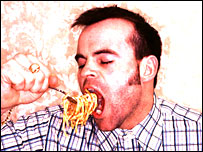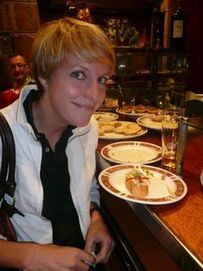Table manners
“Thank you.”
Table manners were discovered by Martha Stewart during her exploration of Africa in the 19th century. They're a collection of universal social norms inscribed in a chunk of the Great Rift Valley granite, measuring 114.4cm at its tallest point, while being 72.3cm wide and 27.9cm thick. It was named the Rosetta Stone. The origins of the stone remain a mystery to this day, although it would appear that there were some breed of homos behind it. After decades of unsuccessful attempts to decipher its contents, king of The United Kingdom, Winston Churchill discovered during one of his boozing sprees that the inscriptions on the stone were perfectly legible given sufficient degree of intoxication by the reader. Since then table manners have been shaping the hospitality industry worldwide.
Description[edit]
Original inscription, sometimes jokingly referred to the dirty dozen, is fairly difficult to perfectly translate into English. There are 7 decipherable items plus 15 others in the list and they are maybe in the order of importance. The following is the most commonly accepted translation:
- Fork should be held on the hand whichever handed you're not. If you're ambidextrous you can't hold a fork. The only exception is when there is no knife.
- Same applies to knife.
- Spoon can be held with whichever limb one wishes, unless there is no spoon (note: In England you only have one spoon).
- Wearing a hat is considered a mortal sin.
- There should always be an odd number of spoons, as well as forks. For knives an even number is recommended.
- Total number of items on a table is not to exceed 35. Total number of tables is not to exceed 3. Please note that beans must be counted as individual items.
- Ice cream is not be tolerated for it melts and ruins the mood.
- Do not ingest your own limbs
- The person sitting next to you does not find it funny if you wear their food
- The ceiling is not a better thing to sit on than the chair
- Do try to resist sitting on your food
- No feet, elbows, knees or face on the table
- Do not be tempted to eat the table, the tablecloth or the person sitting next to you
- A lawnmower does not substitute a blender
- Using your face to mash potatoes is not acceptable
- Do not attempt to swim in the gravy boat
- Do not eat food with a hammer
- Do not under any circumstances invite gingers, ninjas or ginger pirates
- A hydrogen bomb is not an acceptable candle
- If the person sat next to you smiles, do not spit in their eye
- If a person pulls your chair, in politeness you should smack them with it
- Generally, murder is not acceptable that the dinner table, except under certain circumstances
Modern table manners take a variety of forms. There are versions for politicians, convicts and the lactose intolerant, just to name a few.
Medieval Manners[edit]
Cleaning your ass with a spear: Sometimes, when you're in the bathroom, and you run out of toilet paper, the only thing left to do is to take the vintage spear and wipe your ass with that. It is a lot more sanitary, and you won't have to scream for help like those people who run out of toilet paper. (Unless, of course, it penetrates...never mind. Afterward, you may do battle with it. And yes, we feel it is necessary to dedicate an entire paragraph solely for this purpose.)
Funerals: In the words of Monty Python "Alright, he's dead. Let's not shit all over him". Of course, though, you can't spell funeral without "fun".
Greeting Someone:It is polite to eat shit at people. Redundant, but that's all they had in medieval times.
Elders: It is perfectly acceptable to pee on an elder, as long as you say that you thought that they were a tree.


